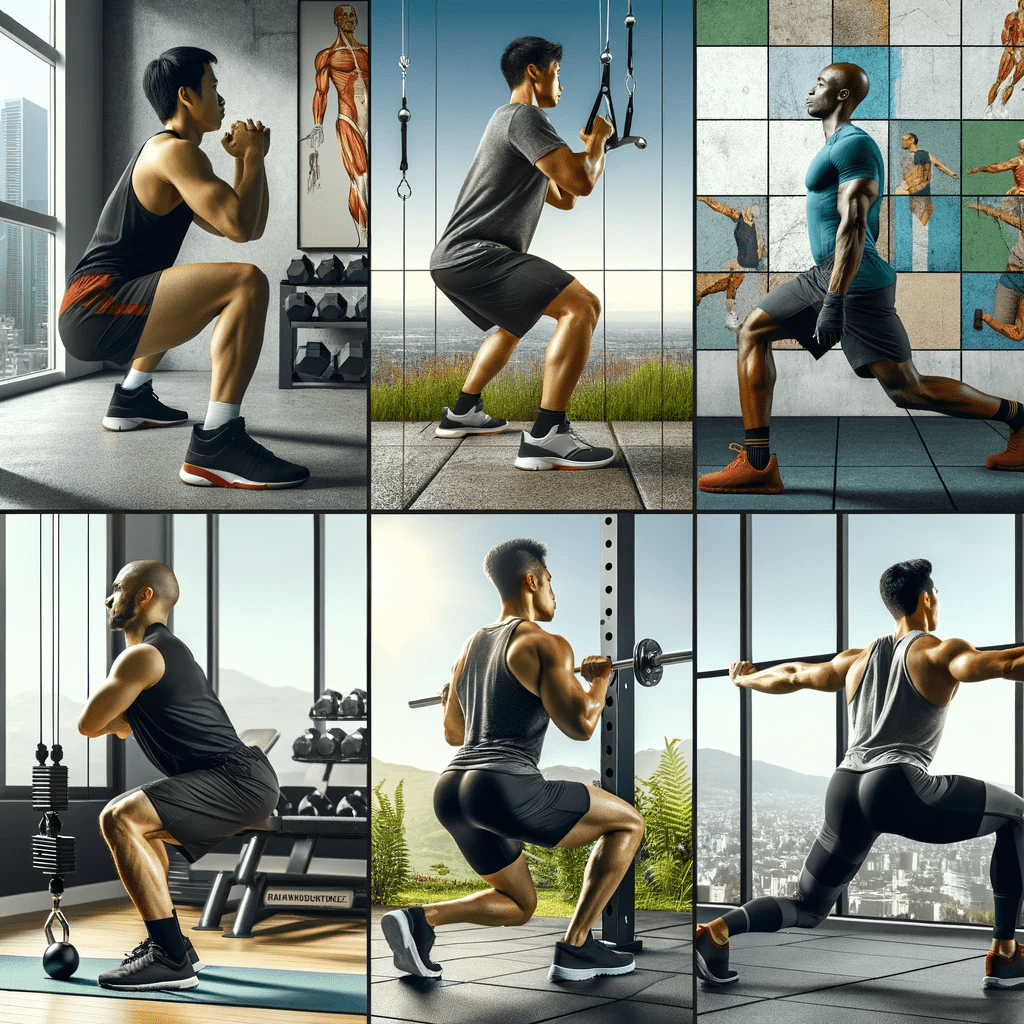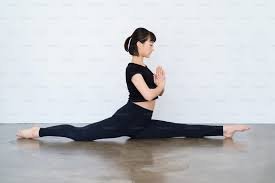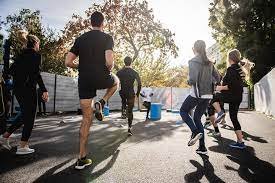Strengthen Your Adductor Exercises: Essential Exercises for Inner Thigh Power
The adductor exercises, a group of muscles located in the inner thigh, are crucial for stability, balance, and overall leg strength. This article, crafted by fitness experts, delves into the most effective exercises to fortify these muscles, ensuring a comprehensive approach to your fitness regimen.
Understanding the Importance of Adductor Strength
The adductors play a pivotal role in your body’s mechanics. Strengthening them not only improves athletic performance but also aids in preventing injuries. Robust adductors contribute to a harmonious muscle balance, supporting activities like running, jumping, and even daily movements.
Expert-Recommended Adductor Exercises
-
Side Lunges for Dynamic Activation
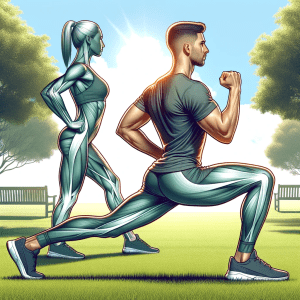
Side lunges are a dynamic way to engage the adductors. They also enhance flexibility and coordination. Ensure proper form by keeping your back straight and bending into the lunge with control.
Side lunges, or lateral lunges, are a great exercise for dynamic activation, especially for the muscles in your legs and hips. They’re particularly useful for engaging the glutes, quadriceps, hamstrings, and adductors (inner thigh muscles), as well as improving balance and lateral (side-to-side) movement ability. Here’s how to perform a side lunge properly:
-
Starting Position:
Stand with your feet together and your hands at your sides or on your hips. Make sure you have enough space on either side to step out.
-
Step Out:
Take a large step to the right with your right foot. As you step out, hinge at your hips and push your buttocks back, bending your right knee. Your left leg should remain straight. The right knee should be aligned with the right foot, not extending past your toes.
-
Lower Your Body:
Lower your body down while keeping your chest up and your core engaged. You should feel a stretch in your inner thigh of the straight leg and engagement in the thigh of the bent leg.
-
Push Back Up:
Push off with your right foot to return to the starting position.
- Repeat on the Other Side:
Perform the same movement on the left side by stepping out with your left foot.
-
Continue Alternating:
Continue alternating sides for the desired number of repetitions.
A few tips for effectiveness and safety:
-
Keep Your Torso Upright:
Avoid leaning forward too much; keep your chest up and look straight ahead.
-
Controlled Movements:
Move into and out of the lunge slowly and with control to maximize muscle engagement and reduce the risk of injury.
-
Depth of the Lunge:
Go as low as you can while maintaining good form, but don’t force it. Depth will improve over time as you gain flexibility and strength.
-
Foot Position:
Keep your feet flat on the ground during the lunge. The heel of the straight leg may lift slightly in deeper lunges, which is okay as long as it’s comfortable and you can maintain balance.
Side lunges are versatile and can be modified for different fitness levels. For beginners, a shallower lunge or holding onto a chair for balance may be helpful. More advanced individuals can hold weights for added resistance. As with any exercise, it’s important to listen to your body and adjust as needed.
-
Sumo Squats for Intense Strengthening
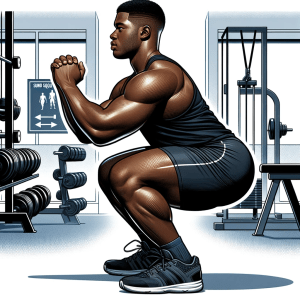
Sumo squats target the adductors more intensely than regular squats. Position your feet wider than shoulder-width and point your toes outward. This variation intensifies the focus on your inner thighs.
Here’s how to perform a sumo squat:
-
Starting Position:
Stand with your feet wider than shoulder-width apart, toes pointing outwards at about a 45-degree angle.
-
Core Engagement:
Engage your core and keep your back straight and chest up. This posture is crucial for balance and to avoid strain on the lower back.
-
Lowering Down:
Bend your knees and lower your body down as if you are sitting back into a chair. Your thighs should aim to become parallel with the floor. Ensure your knees are aligned with your toes and don’t extend past them.
-
Engaging the Glutes and Inner Thighs:
As you lower down, push your knees outwards slightly. This engages the inner thigh muscles and glutes more effectively.
-
The Squat:
Go as low as you can while maintaining a straight back and engaged core. Your weight should be in your heels, allowing you to wiggle your toes.
-
Rising Up:
Push through your heels to return to the starting position. Squeeze your glutes at the top of the movement for maximum benefit.
Benefits:
-
Inner Thigh Toning:
The wide stance targets the adductors (inner thigh muscles).
-
Glute Activation:
Sumo squats are excellent for building glute strength and size.
-
Improved Posture and Balance:
The core engagement required helps in enhancing overall posture and balance.
-
Versatility:
You can add weights (like a dumbbell or kettlebell) to increase intensity.
-
Copenhagen Planks for Core and Adductor Synergy

Copenhagen planks are not only effective for the adductors but also strengthen the core. Balance on one arm and one leg, with the other leg lifted to a bench or a sturdy surface. This exercise challenges your stability and strengthens multiple muscle groups simultaneously. Copenhagen planks are an excellent exercise to target the core muscles, specifically the obliques, as well as the adductors (inner thigh muscles). This exercise not only strengthens these muscle groups but also helps in improving overall stability and muscle synergy. Here’s how you can perform Copenhagen planks:
Equipment
You’ll need a sturdy bench, box, or a similar elevated surface.
Execution
-
Starting Position:
Lie on your side, propping your upper body up with your forearm. The elbow should be directly under your shoulder for proper alignment.
-
Elevate Your Legs:
Place your top leg on the bench or elevated surface, keeping it straight. The lower leg can either be suspended in the air (more challenging) or resting on the ground beneath the bench for a modified version.
-
Lift Your Hips:
Engage your core and lift your hips off the ground, forming a straight line from your head to your top foot. Your weight should be supported by your forearm and your top foot.
-
Hold the Position:
Hold this position, keeping your body straight and hips lifted. Avoid sagging in your hips or waist.
-
Duration:
Aim to hold the plank for a set duration, such as 20-30 seconds to start with, and gradually increase the time as you get stronger.
-
Switch Sides:
After completing the hold on one side, switch to the other side and repeat.
Tips
-
Progression:
Start with a lower bench or box to make the exercise easier. As you gain strength, you can use a higher surface.
-
Breathing:
Breathe steadily while holding the plank. Do not hold your breath.
-
Body Alignment:
Keep your body in a straight line from head to feet. Avoid letting your hips drop.
-
Engagement:
Focus on engaging not only your core and adductors but also your glutes and shoulders for stability.
Variations
-
Modified Copenhagen Plank:
For beginners, instead of suspending the lower leg, you can rest it on the ground or on a lower surface.
-
Dynamic Copenhagen Plank:
Add movement by lowering and raising your hips or by moving your top leg up and down while in the plank position.
Copenhagen planks are a challenging exercise, so it’s important to start slowly and build up your strength and endurance over time. As always, if you’re new to exercise or have any health concerns, it’s a good idea to consult with a fitness professional or healthcare provider before starting a new workout routine.
-
Ball Squeezes for Concentrated Engagement
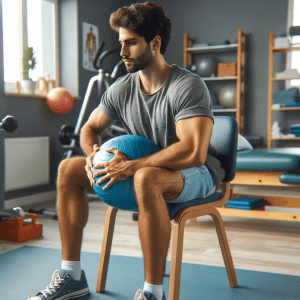
Using an exercise ball, this exercise allows for concentrated adductor engagement. Sit or lie with your knees bent and place the ball between your thighs. Squeeze the ball, hold, and release. It’s excellent for targeting the adductors directly. Ball squeezes are a simple and effective exercise for targeted muscle engagement, particularly useful for strengthening the inner thighs (adductors), the pelvic floor muscles, and to a lesser extent, the hands and the forearms, depending on the type of ball used. This exercise can be performed with various equipment, such as a Pilates ball, a soft foam ball, or even a folded towel.
How to Perform Ball Squeezes
Equipment
- A small, soft ball (like a Pilates ball) or a similarly sized object that can be comfortably squeezed (like a folded towel).
Execution
-
Positioning:
Sit on a chair with your feet flat on the floor, hip-width apart. Place the ball between your knees or just above them (inner thighs).
-
Engage Your Muscles:
Engage your core and pelvic floor muscles. Then, gently squeeze the ball with your inner thighs. The pressure should be controlled and steady.
-
Hold and Release:
Hold the squeeze for a few seconds (start with 3-5 seconds), then release gently. Avoid releasing the tension completely; maintain a slight pressure on the ball even in the ‘rest’ phase.
-
Repetitions:
Start with a set of 10-15 squeezes and gradually increase as your strength improves.
-
Breathing:
Breathe normally throughout the exercise. Exhale during the squeeze phase, and inhale when releasing.
Tips
-
Posture:
Maintain good posture throughout the exercise. Keep your back straight and your shoulders relaxed.
-
Intensity:
Adjust the intensity by varying the pressure applied to the ball. Start gently and increase as you get stronger.
-
Control:
Perform the exercise in a controlled manner. Avoid jerky or rapid movements.
-
Consistency:
Incorporate this exercise regularly into your routine for better results.
Variations
-
Lying Down:
You can also perform this exercise while lying on your back with your knees bent and feet flat on the floor.
-
Standing:
For a more challenging variation, try standing with your back against a wall, with the ball placed in the same position between your thighs.
Ball squeezes are particularly beneficial for individuals looking to strengthen their inner thigh muscles, improve pelvic stability, and for women post-pregnancy to regain pelvic floor strength. However, as with any exercise, it’s important to ensure you’re performing it correctly to avoid any potential strain or injury. If you have any specific health concerns, it’s advisable to consult with a healthcare provider or a qualified fitness instructor before starting a new exercise.
-
Cable Machine Adductions for Targeted Strengthening
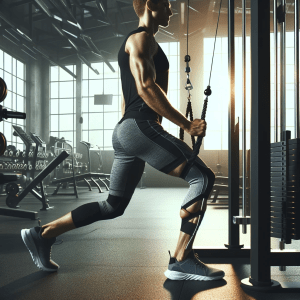
Cable machines offer a way to add resistance to your adductor workout. Attach the cable to your ankle and pull inward, against the resistance, focusing on the inner thigh. Cable machine adductions are an excellent exercise for targeted strengthening of the adductor muscles, which are located on the inner thigh. This exercise is performed using a cable machine, which provides adjustable resistance and can help in developing strength, stability, and muscle tone in the adductors. It’s particularly beneficial for athletes, dancers, or anyone looking to enhance lower body strength and stability.
How to Perform Cable Machine Adductions
Equipment
- A cable machine with an adjustable height pulley.
- An ankle strap attachment.
Execution
-
Setup:
Attach the ankle strap to the lowest setting on the cable machine, and then secure it around your ankle. Choose an appropriate weight on the machine – start light and increase as you get accustomed to the movement.
-
Starting Position:
Stand with the side of your body that is not attached to the cable facing the machine. Your feet should be hip-width apart, and your posture should be upright. Hold onto the machine for balance if needed.
-
Movement:
Shift your weight slightly to the foot that’s not attached to the cable. Then, engage your core and slowly bring the strapped leg across the front of your body, moving only at the hip joint. The movement should be controlled and initiated by your inner thigh muscles.
-
Return:
Slowly return your leg to the starting position, controlling the weight as you move.
-
Repetitions and Sets:
Perform a set of 10-15 repetitions, then switch the strap to the other ankle and repeat with the other leg. Aim for 2-3 sets per leg.
Tips
-
Controlled Movement:
Ensure the movement is slow and controlled. Avoid swinging the leg or using momentum.
-
Posture:
Maintain an upright posture throughout the exercise. Avoid leaning too far to the side.
-
Range of Motion:
Move through a comfortable range of motion; don’t force your leg too far across your body.
-
Weight Selection:
Start with a lighter weight to focus on form and prevent injury. Increase the weight as you become more comfortable with the movement.
Variations
-
Standing Cable Hip Adduction:
Instead of bringing the leg across the front of your body, you can also perform this exercise by moving your leg sideways towards the midline of your body, which targets the adductors differently.
-
Speed Variations:
Playing with the speed of the movement (faster concentric phase or slower eccentric phase) can challenge the muscles in different ways.
Cable machine adductions are an effective way to isolate and strengthen the inner thigh muscles. This exercise can be integrated into a lower body workout routine or a sport-specific training program. As with any resistance training, it’s important to ensure proper form and gradually progress in weight to avoid injury. If you’re new to resistance training or have any specific health concerns, it’s a good idea to seek advice from a fitness professional.
Incorporating Adductor Exercises into Your Routine
A balanced workout plan should include adductor exercises. Start with lighter weights or fewer repetitions, gradually increasing intensity. Consistency is key, and it’s essential to pair these exercises with a well-rounded fitness routine.
Frequently Asked Questions
-
How often should I train my adductors?
Aim for 2-3 times a week, allowing sufficient recovery time between sessions.
-
Can adductor exercises help reduce inner thigh fat?
While these exercises strengthen the inner thigh muscles, fat reduction is best achieved through a combination of strength training, cardio, and a healthy diet.
-
Are there any specific stretches for the adductors?
Yes, stretches like the butterfly stretch and side lunges can effectively increase adductor flexibility.
-
Is it normal to feel sore after adductor workouts?
Mild soreness is normal as your muscles adapt to new exercises. However, sharp pain or excessive discomfort may indicate overexertion.
-
Can I do adductor exercises at home without equipment?
Absolutely. Exercises like side lunges and sumo squats can be done effectively without any equipment.
Conclusion
Strengthening your adductors is an essential part of a balanced fitness regime. By incorporating these expert-recommended exercises, you’ll experience enhanced stability, improved athletic performance, and reduced risk of injury. Remember, gradual progression and consistency are your allies in this journey towards stronger, more resilient inner thighs.

